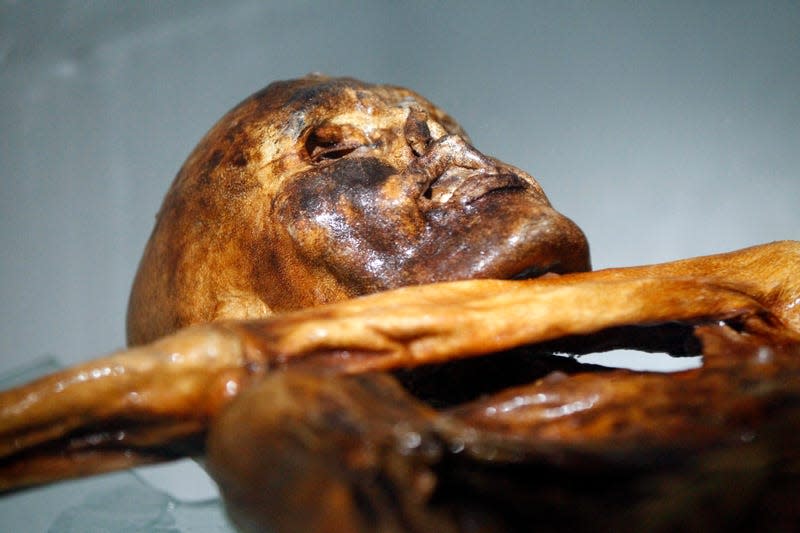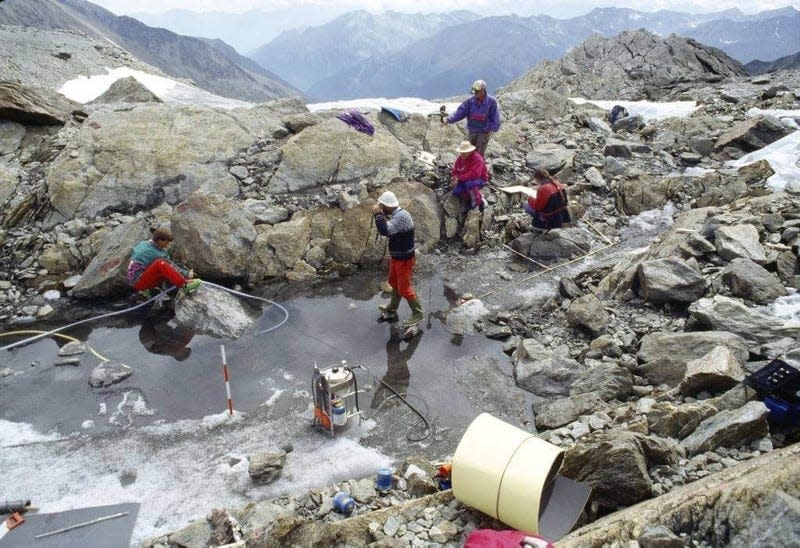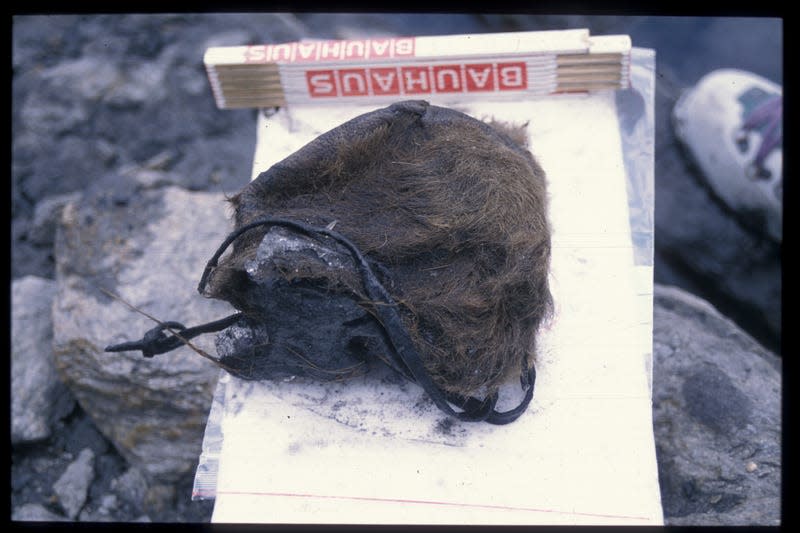A Stone Age Cold Case: Ötzi the ‘Iceman’ Thawed and Refroze Many Times, Researchers Say

- Oops!Something went wrong.Please try again later.
Ötzi, a 5,300-year-old mummy discovered in 1991.
In 1991, a pair of climbers encountered a human body sticking out of the ice high in the Italian alps. Though its skin was preserved—complete with tattoos—the body turned out to be 5,300-year-old remains, mummified by the frigid, dry conditions in which the man died. Now known as Ötzi, the famously well-preserved mummy has given researchers a remarkable look into the life of a Stone Age person.
But recent analysis of 30 years of scholarship suggests the story of Ötzi’s death and subsequent mummification may need revision. The common tale—based on initial analysis of the remains and follow-up studies in the early 2000s—is that Ötzi was fatally wounded and staggered into the Alps to escape his assailant. He died there and rapidly froze, where his remains (and his toolkit) remained for the next five millennia.
Read more
A team of archaeologists now posit that Ötzi was not immediately buried in ice and was repeatedly exposed to the elements over the next 1,500 years. The team’s research was published this week in The Holocene.

The Ötzi excavation site, high in the Alps.
“The story is so at odds with how glacial archaeological sites work,” said Lars Pilø, a glacial archaeologist and the study’s lead author, in an email to Gizmodo. “We conclude that the find circumstances surrounding Ötzi are not a string of miracles, but can be better explained by normal processes on glacial archaeological sites.”
Ötzi’s remains likely melted out of the ice many times, the researchers say. Rather than being frozen in time and space from the Stone Age until 1991 thanks to some superlative good fortune, Ötzi thawed out and refroze and was moved around the mountaintop as the environment changed, according to the study.
Ötzi was in a gully, which was previously thought to have allowed the mummy’s preservation despite the movement of ice above it; this team contends that Ötzi actually died elsewhere on the mountain and was eventually moved down into the gully by ordinary environmental changes.
“This is a good thing,” Pilø added, “because it raises the probability of finding another ice mummy elsewhere, when no exceptional circumstances are needed.”
Ötzi is as ancient to Tutankhamun as the Emperor Claudius is to us. But the preservation of the mummy has given scientists a rare opportunity to look directly back in time. Analysis of the mummy’s colon, stomach, and the isotopes in its hair revealed the Iceman’s diet: ibex and red deer, cereals, and toxic fern. Isotope ratios in Ötzi’s ax traced its origins to Southern Tuscany. Scientists have even counted all 61 tattoos on the ancient man’s shriveled skin.
The team also believes that the mummy’s tools—Ötzi was found with a backpack frame, a fur cap, a quiver, and an ax—were damaged by the elements rather than by his ancient assailant. The team’s conclusions draw on years of Ötzi scholarship, which proffer an exhaustive list of possibilities for how the Stone Age man ended up dead and mummified so high in the mountains.

Ötzi’s fur cap, as seen when it was first discovered.
Pilø is also the author of the Secrets of the Ice blog, a site devoted to glacial archaeology, especially items found thawing from glaciers in Northern Europe. Climate change has accelerated the discovery of these objects, especially from ice patches, which treat frozen materials much more gently than dynamic glaciers, which have a propensity for grinding objects into oblivion. In 2020, a trove of hunting artifacts was found in an ice patch in Norway; in another ice patch, once a Viking mountain pass, researchers found the remains of a dog, its leash, mittens, shoes, and parts of a sled.
Just last year, a 1,300-year-old ski appeared out of thawing ice. Though not as superlative as Ötzi, discoveries like these will become more frequent as ice melts in a warming climate, Pilø said.
And based on the team’s findings, preserved human remains may appear more frequently, too. If Ötzi wasn’t an extremely fortuitous situation of preservation, more mummies may soon emerge from the ice.
More: Final Days of Ötzi the Iceman Revealed Through New Analysis of His Tools
More from Gizmodo
The Best Shortcuts On Mac: Snap Windows, Text to Speech, and More
How to Delete Your Twitter Account If Elon Musk Was Your Last Straw
Sign up for Gizmodo's Newsletter. For the latest news, Facebook, Twitter and Instagram.
